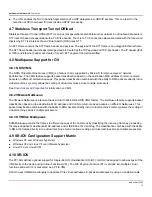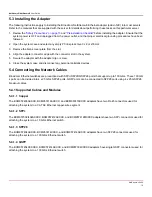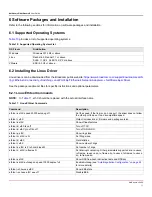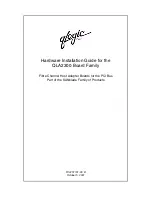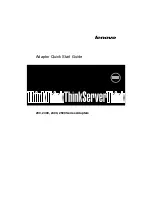
NetXtreme-UG100
9
NetXtreme-C/NetXtreme-E
User Guide
4 Features
Refer to the following sections for device features.
4.1 Software and Hardware Features
Table 6
provides a list of host interface features.
Table 6: Host Interface Features
Feature
Details
Host Interface
PCIe 3.0 (Gen 3: 8 GT/s; Gen 2: 5 GT/s; Gen 1: 2.5 GT/s).
Number of PCIe lanes
PCIe Edge connector: x16.
Vital Product Data (VPD)
Supported.
Alternate Routing ID (ARI)
Supported.
Function Level Reset (FLR)
Supported.
Advanced Error Reporting
Supported.
PCIe ECNs
Support for TLP Processing Hints (TPH), Latency Tolerance
Reporting (LTR), and Optimized Buffer Flush/Fill (OBFF).
MSI-X Interrupt vector per queue
1 per RSS queue, 1 per NetQueue, 1 per Virtual Machine Queue
(VMQ).
IP Checksum Offload
Support for transmit and receive side.
TCP Checksum Offload
Support for transmit and receive side.
UDP Checksum Offload
Support for transmit and receive side.
NDIS TCP Large Send Offload
Support for LSOV1 and LSOV2.
NDIS Receive Segment Coalescing (RSC)
Support for Windows environments.
TCP Segmentation Offload (TSO)
Support for Linux and VMware environments.
Large Receive Offload (LRO)
Support for Linux and VMware environments.
Generic Receive Offload (GRO)
Support for Linux and VMware environments.
Receive Side Scaling (RSS)
Support for Windows, Linux, and VMware environments. Up to
8 queues/port supported for RSS.
Header-Payload Split
Enables the software TCP/IP stack to receive TCP/IP packets
with header and payload data split into separate buffers.
Supports Windows, Linux, and VMware environments.
Jumbo Frames
Supported.
iSCSI boot
Supported.
NIC Partitioning (NPAR)
Supports up to eight Physical Functions (PFs) per port, or up to
16 PFs per silicon. This option is configurable in NVRAM.












